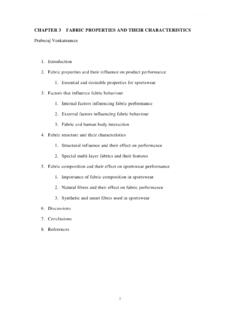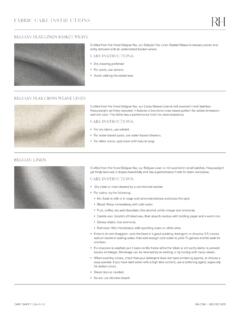Transcription of TEXTILE DYEING - CottonWorks™
1 1 TEXTILE DYEING 2 TEXTILE DYEING Introduction Color is an extremely important aspect of modern textiles . The color of a TEXTILE product is a major factor in the marketing and use of that product. The color of textiles can be used to differentiate groups of people such as uniforms used for athletic teams, hospital personnel or military organizations. Color can also be functional such as camouflage or protective uniforms. However, in the modern retail store, the color of TEXTILE products is a major contributor to what is referred to as fashion.
2 The color is very important with apparel, carpet, upholstery, curtains, drapes, sheets and towels. All of the items are marketed with an emphasis on their specific color. TEXTILE Coloration DYEING is the application of color to a TEXTILE material with some degree of fastness or permanence. The materials which impart the color are known as colorants. When these colorants have a natural affinity and permanence on textiles , they are referred to as dyes. Dyes actually migrate or diffuse into the chemical molecular structure of TEXTILE fibers in order to develop the final color of the TEXTILE product.
3 The dye-fiber molecular association is also responsible for the degree of fastness or permanence of the color because of the molecular attraction between the specific dye and the specific TEXTILE fiber; dyes are classified as being fiber specific. That is, dyes which work on cotton will not work on polyester, nylon, acrylic, wool and many other commonly used TEXTILE fibers. However, because the basic structure of cotton is cellulose, the dyes which work on cotton will also work on other cellulose based fibers such as linen, ramie, rayon and lyocell.
4 It should be noted that the color actually produced on cotton by any single dye or combination of dyes will not necessarily match the color produced when these same dyes are used on linen or ramie or rayon. Many unique factors contribute to the color produced by TEXTILE DYEING including fiber properties. This situation will be discussed in more detail later in this document. The other colorant used on TEXTILE fibers are pigments. Pigments unlike dyes, have no natural affinity for TEXTILE fibers. In order to produce permanent color on TEXTILE products, pigments are bound to the surface of the TEXTILE fibers using adhesives or glues which are known as binders.
5 There is a wide variety of binder systems available with various properties. Their specific advantages and limitations will be discussed later. However, it is important to note that pigment colorants have no permanence on TEXTILE fibers without using some type of binder system. Additionally, many of the binders work on 3 many different types of fibers. Unlike dyes, pigments are not fiber specific. The same pigment binder combination can work on both cotton and polyester at the same time. Historically, TEXTILE DYEING predates written history.
6 There is evidence that indigo and other plant based dyes were known and in use around 4000 BC. The modern countries such as Egypt, India, and China have archeological evidence of highly developed ancient TEXTILE products and processes. Mixing of existing dyes to produce multiple shades in wide color gamut was a common practice over 2000 years ago. Natural Dyes Until 1856, all textiles used throughout the world were natural dyes. That is, these dyes were obtained directly from the natural environment in one way or another. The vast majority of the natural dyes came from either plants or animals.
7 For example, a major dye discovered by the Aztec or Mayan Indians was cochineal . It is a relatively bright red that is obtained from the body of the cochineal insect. The insect must be crushed and the dye is refined from the remains of the insect. Reportedly, 70,000 insects are required to produce one pound of dye. Cochineal is still used today as a natural commercial product in both TEXTILE DYEING and in food coloring. Another natural animal dye which had a tremendous impact in the ancient world was Tyrian Purple.
8 This dye was discovered near the ancient city of Tyre, which is in Lebanon. It was discovered that when a sea mollusk native to the Tyre coastal region was crushed and refined, an extremely bright purple dye was produced. This dye exhibited very good fastness properties compared to other natural dyes. However, this dye was also very rare and difficult to produce. It took approximately 12,000 sea mollusks to produce one gram of dye. It should be noted that there are approximately 454 grams in one pound. Because of the brightness and rarity, Tyrian Purple was highly prized but also extremely expensive.
9 Only the wealthiest in society, such as kings and queens, could afford this dye. From ancient times until today, the monarchies surrounding the Mediterranean Sea have purple robes as part of the royal heritage. Today, the Tyrian Purple sea mollusk is extinct, but the dye can be made synthetically. The most well known and most used dye of all time is indigo . This dye is obtained from the leaves, stems and beans of a variety of plants, including one variety known as the indigo plant. In order to obtain the dye, the harvested plant matter is fermented over several weeks time.
10 The dye itself is the major product of the fermentation process. Figure 1 shows the indigo plants and beans, as well as, the fermentation process. After fermentation, the water insoluble solid indigo is washed to remove impurities and dried. This results in a powdery solid dye. In order to dye TEXTILE fibers, especially cotton, the indigo must be made water soluble by a chemical process known as reduction. The water soluble reduced indigo is rapidly absorbed by the cotton fibers. 4 Once inside the fiber structure, oxygen in the air converts the indigo back to its original, water insoluble form, as is illustrated above.








